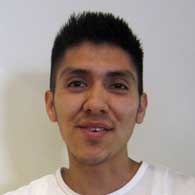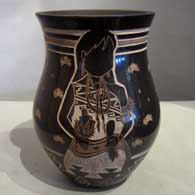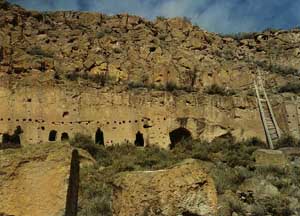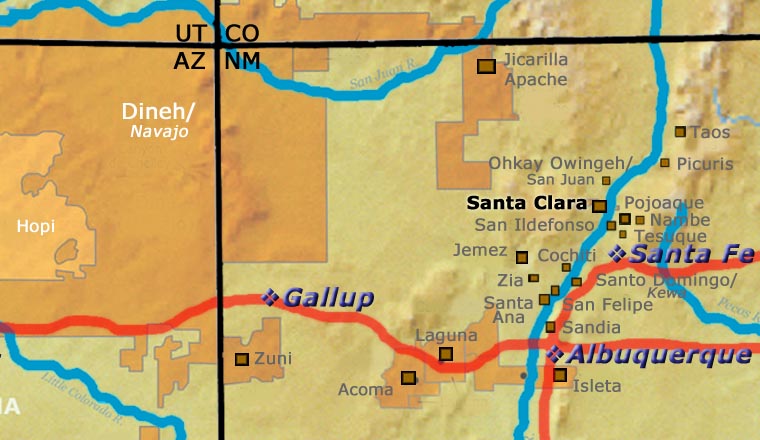
Johnathan Naranjo
Santa Clara

Johnathan Naranjo, born in July, 1987 at Santa Clara Pueblo, is the son of Karen Price and a grandson of famed potter Bernice Naranjo. Other well-known potters in the family include Dusty Naranjo and Caroline Elliot. While he began learning to make pottery as a child with his grandmother, it is really only in the last few years that his work has evolved into his distinctive style. Each of his pieces are hand-coiled and stone polished. The overall coloration is attained during the firing: each piece is taken out of the fire-smothering manure early so it remains a darker brown and doesn't turn totally black. He then incises his designs into the clay, controlling the various colorations of the tan and red by carefully controlling the depth of each incision.
Johnathan has participated in shows at the Heard Museum in Phoenix, the National Museum of the American Indian in Washington, DC, the American Indian Arts Marketplace at the Autry National Center in Los Angeles, the Haskell Indian Art Market in Lawrence, Kansas and the Santa Fe Indian Market.
In 2013 Johnathan was awarded the "Tony Da" award at the Santa Fe Indian Market for his innovative and intricate style of pottery. He has also earned the Legacy Award in Santa Fe and in 2014 he earned the First Place ribbon for Contemporary Pottery. In 2023, he was awarded the First Place ribbon for Pottery, Classification II C: Category 704 - Incised or carved, any form, at the Santa Fe Indian Market.
Johnathan told us his favorite shapes to make are pottery sculptures. His favorite designs are sourced from his tribal influences: Santa Clara, Taos and Navajo. As much as he obviously enjoys making his pottery, he is also an avid fisherman, hiker, basketball player (and fan), artist, traveler and long distance runner.
Some Awards Won by Johnathan
- 2024 Santa Fe Indian Market, Classification II-C: Category 701 - Carved or Incised, Black or Red, Under 8 inches, Second Place
- 2024 Santa Fe Indian Market, Classification IID: Sgraffito, any form, Honorable Mention
- 2023 Santa Fe Indian Market, Classification II-C, Category 704 - Incised or carved, any form, First Place
- 2023 Santa Fe Indian Market, Classification II-F, Category 1001 - Traditional, Honorable Mention
- 2019 Santa Fe Indian Market, Classification II - Pottery, Division C - Traditional burnished black or red ware, incised, painted or carved, Category 701 - Carved or incised, black or red, under 8": First Place
- 2019 Santa Fe Indian Market, Classification II - Pottery, Division D - Contemporary pottery, any form or design, using Native materials with or without added decorative elements, traditional firing techniques, Category 801 - Sgraffitto, any form: Honorable Mention
- 2016 Heard Museum Guild Indian Fair & Market, Classification II - Pottery, Division B - Traditional, native clay, hand built, unpainted including ribbed: Second Place
- 2015 Heard Museum Guild Indian Fair & Market, Classification II - Pottery, Division C - Traditional - native clay, hand built, carved: Second Place. Awarded for artwork: "Birds of Spring" bottle
100 West San Francisco Street, Santa Fe, New Mexico 87501
(505) 986-1234 - www.andreafisherpottery.com - All Rights Reserved

Santa Clara Pueblo

Ruins at Puye Cliffs, Santa Clara Pueblo
Santa Clara Pueblo straddles the Rio Grande about 25 miles north of Santa Fe. Of all the pueblos, Santa Clara has the largest number of potters.
The ancestral roots of the Santa Clara people have been traced to ancient pueblos in the Mesa Verde region in southwestern Colorado. When that area began to get dry between about 1100 and 1300 CE, some of the people migrated eastward, then south into the Chama River Valley where they constructed several pueblos over the years. One was Poshuouinge, built about 3 miles south of what is now Abiquiu on the edge of the Jemez foothills above the Chama River. Eventually reaching two and three stories high, and with up to 700 rooms on the ground floor, Poshuouinge was occupied from about 1375 CE to about 1475. Drought then again forced the people to move, some of them going to the area of Puye (on the eastern slopes of the Pajarito Plateau of the Jemez Mountains) and others downstream to Ohkay Owingeh (San Juan Pueblo, along the Rio Grande). Beginning around 1580 CE, drought forced the residents of the Puye area to relocate closer to the Rio Grande and they founded what we now know as Santa Clara Pueblo on the west bank of the river, with San Juan Pueblo to the north and San Ildefonso Pueblo to the south.
In 1598 the seat of Spanish government was established at Yunque, near San Juan Pueblo. The Spanish proceeded to antagonize the Puebloans so badly that that government was moved to Santa Fe in 1610, for their own safety.
Spanish colonists brought the first missionaries to Santa Clara in 1598. Among the many things they forced on the people, those missionaries forced the construction of the first mission church around 1622. However, like the other pueblos, the Santa Clarans chafed under the weight of Spanish rule. As a result, they were in the forefront of the Pueblo Revolt of 1680. One Santa Clara resident, a mixed black and Tewa man named Domingo Naranjo, was one of the rebellion's ringleaders. However, the pueblo unity that allowed them to chase the Spanish out fell apart shortly after their success, especially after Popé died.
When Don Diego de Vargas came back to the area in 1694, he found most of the Santa Clarans on top of nearby Black Mesa (with the people of San Ildefonso). A six-month siege didn't subdue them so finally, the two sides negotiated a treaty and the people returned to their pueblos. However, successive invasions and occupations by northern Europeans took their toll on all the tribes over the next 250 years. Then the swine flu pandemic in 1918 almost wiped them out.
Today, Santa Clara Pueblo is home to as many as 2,600 people and they comprise probably the largest per capita number of artists of any North American tribe (estimates of the number of potters run as high as 1-in-4 residents).
Today's pottery from Santa Clara is typically either black or red. It is usually highly polished and designs might be deeply carved or etched ("sgraffito") into the pot's surface. The water serpent, (avanyu), is a very common traditional design motif on Santa Clara pottery. Another motif comes from the legend that a bear helped the people find water during a drought. The bear paw has appeared on much of their pottery ever since.
Santa Clara has received a lot of distinction because of the evolving artistry the potters have brought to their craft. Not only did this pueblo produce excellent black and redware, several notable innovations helped move pottery from the realm of utilitarian vessels into the domain of art. Different styles of polychrome redware emerged in the 1920s-1930s. In the early 1960s experiments with stone inlay, incising and double firing began. Modern potters have also extended the tradition with unusual shapes, slips and designs, illustrating what one Santa Clara potter said: "At Santa Clara, being non-traditional is the tradition." (This refers strictly to artistic expression; the method of creating pottery remains traditional).
Santa Clara Pueblo is home to a number of famous pottery families: Tafoya, Baca, Gutierrez, Naranjo, Suazo, Chavarria, Garcia, Vigil, and Tapia - to name a few.
100 West San Francisco Street, Santa Fe, New Mexico 87501
(505) 986-1234 - www.andreafisherpottery.com - All Rights Reserved


